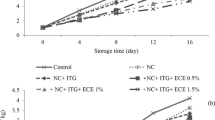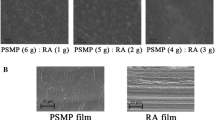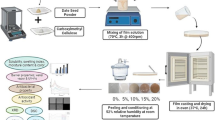Abstract
Cottonseed meal protein (CSP) film containing nanoclay and carvacrol was prepared, and the physical properties of the film were investigated. Nanoclay (Cloisite Na+) incorporation improved mechanical properties of the CSP film. CSP film containing 3% nanoclay had tensile strength of 4.07 MPa and elongation at break of 26.37%. The optimal condition for the CSP film manufacturing was 3 g cottonseed protein, 3 g fructose, and 0.09 g Cloisite Na+ in 100 mL of film-forming solution. To inhibit the growth of pathogenic bacteria such as Escherichia coli O157:H7, CSP film containing carvacrol was prepared, and microbial growth was examined during bacon packaging and storage using the film. The antimicrobial activity of the CSP film against E. coli O157:H7 increased with increasing carvacrol concentration. After 10 d of storage, the population of E. coli O157:H7 inoculated on the bacon samples packed with the CSP film containing carvacrol decreased by 1.57 log CFU/g compared to the control. These results suggest that the CSP film containing carvacrol can be used as an antimicrobial packaging film.
Similar content being viewed by others
References
Arrebola ML, Navarro MC, Jimenez J, and Ocana FA (1994) Yield and composition of the essential oil of thymus serpylloides subsp serpylloides. Phytochemistry 36, 67–72.
Bae HJ, Park HJ, Darby DO, Kimmel RM, and Whiteside WS (2009) Development and characterization of pet/fish gelatin-nanoclay composite/ldpe laminate. Packag Technol Sci 22, 371–383.
Benavides S, Villalobos-Carvajal R, and Reyes JE (2012) Physical, mechanical and antibacterial properties of alginate film: Effect of the crosslinking degree and oregano essential oil concentration. J Food Eng 110, 232–239.
Burt SA, Fledderman MJ, Haagsman HP, F van Knapen, and Veldhuizen EJA (2007) Inhibition of salmonella enterica serotype enteritidis on agar and raw chicken by carvacrol vapour. Int J Food Microbiol 119, 346–350.
Burt SA and Reinders RD (2003) Antibacterial activity of selected plant essential oils against Escherichia coli O157:H7. Lett Appl Microbiol 36, 162–167.
Chen P and Zhang L (2006) Interaction and properties of highly exfoliated soy protein/montmorillonite nanocomposites. Biomacromolecules 7, 1700–1706.
Cho SY and Rhee C (2002) Sorption characteristics of soy protein films and their relation to mechanical properties. Lebensm-Wiss Technol 35, 151–157.
Du WX, Olsen CW, Avena-Bustillos RJ, McHugh TH, Levin CE, and Friedman M (2008) Antibacterial activity against e-coli o157:H7, physical properties, and storage stability of novel carvacrol-containing edible tomato films. J Food Sci 73, M378–M383.
Fornes TD, Yoon PJ, Keskkula H, and Paul DR (2001) Nylon 6 nanocomposites: the effect of matrix molecular weight. Polymer 42, 9929–9940.
Grevellec J, Marquie C, Ferry L, Crespy A, and Vialettes V (2001) Processability of cottonseed proteins into biodegradable materials. Biomacromolecules 2, 1104–1109.
Hanani ZAN, Roos YH, and Kerry JP (2012) Use of beef, pork and fish gelatin sources in the manufacture of films and assessment of their composition and mechanical properties. Food Hydrocolloid 29, 144–151.
Hong YH, Lim GO, and Song KB (2009) Physical properties of Gelidium corneum-gelatin blend films containing grapefruit seed extract or green tea extract and its application in the packaging. J Food Sci 74, C6–C10.
Jang SA, Shin YJ, Seo YB, and Song KB (2011) Effects of various plasticizers and nanoclays on the mechanical properties of red algae film. J Food Sci 76, N30–N34.
Ku KJ, Hong YH, and Song KB (2008) Mechanical properties of a gelidium corneum edible film containing catechin and its application in sausages. J Food Sci 73, C217–C221.
Laemmli UK (1970) Cleavage of structural proteins during the assembly of the head of bacteriophage t4. Nature 227, 680–685.
Lagouri V, Blekas G, Tsimidou M, Kokkini S, and Boskou D (1993) Composition and antioxidant activity of essential oils from oregano plants grown wild in greece. Z Lebensmittel-Unters For 197, 20–23.
Lam CK, Lau KT, Cheung HY, and Ling HY (2005) Effect of ultrasound sonication in nanoclay clusters of nanoclay/epoxy composites. Mater Lett 59, 1369–1372.
Lepoittevin B, Devalckenaere M, Pantoustier N, Alexandre M, Kubies D, Calberg C et al. (2002) Poly(-caprolactone)/clay nanocomposites prepared by melt intercalation: mechanical, thermal and rheological properties. Polymer 43, 4017–4023.
Liadakis GN, Floridis A, Tzia C, and Oreopoulou V (1993) Protein isolates with reduced gossypol content from screw-pressed cottonseed meal. J Agr Food Chem 41, 918–912.
Lim GO, Hong YH, and Song KB (2010) Application of gelidium corneum edible films containing carvacrol for ham packages. J Food Sci 75, C90–C93.
Luecha J, Sozer N, and Kokini JL (2010) Synthesis and properties of corn zein/montmorillonite nanocomposite films. J Mater Sci 45, 3529–3537.
Marquie C (2001) Chemical. Reactions in cottonseed protein cross-linking by formaldehyde, glutaraldehyde, and glyoxal for the formation of protein films with enhanced mechanical properties. J Agr Food Chem 49, 4676–4681.
Marquie C and Guilbert S (2002) Formation and properties of cottonseed protein films and coatings. In Protein-based Films and Coatings. Gennadios A (1st ed), pp. 139–158, CRC Press, USA.
Marquie C, Tessier AM, Aymard C, and Guilbert S (1997) Hplc determination of the reactive lysine content of cottonseed protein films to monitor the extent of cross-linking by formaldehyde, glutaraldehyde, and glyoxal. J Agr Food Chem 45, 922–926.
Martinez-Romero D, Guillen F, Valverde JM, Bailen G, Zapata P, Serrano M et al. (2007) Influence of carvacrol on survival of botrytis cinerea inoculated in table grapes. Int J Food Microbiol 115, 144–148.
Min BJ and Oh JH (2009) Antimicrobial activity of catfish gelatin coating containing origanum (Thymus capitatus) oil against gram-negative pathogenic bacteria. J Food Sci 74, M143–M148.
Oussalah M, Caillet S, Salmieri S, Saucier L, and Lacroix M (2004) Antimicrobial and antioxidant effects of milk protein-based film containing essential oils for the preservation of whole beef muscle. J Agr Food Chem 52, 5598–5605.
Park HM, Li XC, Jin CZ, Park CY, Cho WJ, and Ha CS (2002) Preparation and properties of biodegradable thermoplastic starch/clay hybrids. Macromol Mater Eng 287, 553–558.
Pranoto Y, Salokhe VM, and Rakshit SK (2005) Physical and antibacterial properties of alginate-based edible film incorporated with garlic oil. Food Res Int 38, 267–272.
Ravishankar S, Zhu LB, Olsen CW, McHugh TH, and Friedman A (2009) Edible apple film wraps containing plant antimicrobials inactivate foodborne pathogens on meat and poultry products. J Food Sci 74, M440–M445.
Rojas-Grau MA, Avena-Bustillos RJ, Olsen C, Friedman M, Henika PR, Martin-Belloso O et al. (2007) Effects of plant essential oils and oil compounds on mechanical, barrier and antimicrobial properties of alginate-apple puree edible films. J Food Eng 81, 634–641.
Sadeghi AA and Shawrang P (2007) Effects of microwave irradiation on ruminal protein degradation and intestinal digestibility of cottonseed meal. Livest Sci 106, 176–181.
Saroso B (1989) Chemical properties of protein in cottonseed kernels. Industr Crops Res J 1, 60–65.
Shaw NB, Monahan FJ, O’Riordan ED, and O’sullivan M (2002) Physical properties of wpi films plasticized with glycerol, xylitol, or sorbitol. J Food Sci 67, 164–167.
Shin YJ, Jang SA, and Song KB (2011) Preparation and mechanical properties of rice bran protein composite films containing gelatin or red algae. Food Sci Biotechnol 20, 703–707.
Ultee A., Bennik MHJ, and Moezelaar R (2002) The phenolic hydroxyl group of carvacrol is essential for action against the food-borne pathogen bacillus cereus. Appl Environ Microb 68, 1561–1568.
Wan VCH, Kim MS, and Lee SY (2005) Water vapor permeability and mechanical properties of soy protein isolate edible films composed of different plasticizer combinations. J Food Sci 70, E387–E391.
Xu YX, Ren X, and Hanna MA (2006) Chitosan/clay nanocomposite film preparation and characterization. J Appl Polym Sci 99, 1684–1691.
Zivanovic S, Chi S, and Draughon AF (2005) Antimicrobial activity of chitosan films enriched with essential oils. J Food Sci 70, M45–M51.
Author information
Authors and Affiliations
Corresponding author
Rights and permissions
About this article
Cite this article
Jo, WS., Song, HY., Song, Nb. et al. Preparation of a cotton seed meal protein/nanoclay composite film containing carvacrol and its effect on the growth of escherichia coli O157:H7 inoculated on bacon during storage. J Korean Soc Appl Biol Chem 55, 651–656 (2012). https://doi.org/10.1007/s13765-012-2100-y
Received:
Accepted:
Published:
Issue Date:
DOI: https://doi.org/10.1007/s13765-012-2100-y




